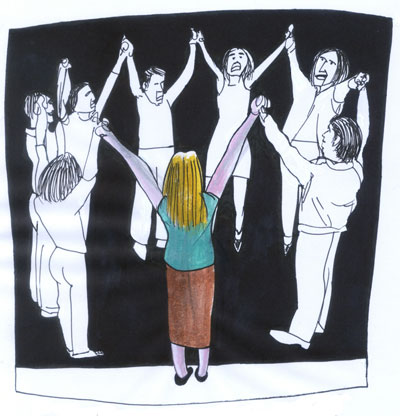 Every Saturday, we’ll be posting a new illustration by David Lester. The Mecca Normal guitarist is visually documenting people, places and events from his band’s 28-year run, with text by vocalist Jean Smith.
Every Saturday, we’ll be posting a new illustration by David Lester. The Mecca Normal guitarist is visually documenting people, places and events from his band’s 28-year run, with text by vocalist Jean Smith.
Mid-afternoon most days, the four abstract painters took a vote to reconvene at the Japanese restaurant down the street. The vote itself was an absurdist tip of the hat to their mutual interest in anarchist social theory and surrealist art. The results of the vote were meaningless. Unless one of them was doing the evening shift at Opus, they’d all wander down to Aikoko to talk about art with plenty of hot sake to refill their tiny cups, and two hours later they’d vote again to decide whether they were going back to the studio or carry on to the bar. In actuality, each of them decided individually and went on about his personal business regardless of the results of the vote. Their daily ritual, happy hour at Aikoko, was an extravagance they probably couldn’t afford, but couldn’t resist. It became known as taking a vote.
Over plates of deeply discounted spicy negitoro rolls and octopus sunomono, conversation invariably turned to Jeff’s idea of using part of the studio space as a gallery where they could invite potential buyers to see their work. Adam maintained this would destroy the purity of the creative environment. He didn’t want to overhear customers prattling about the price of a painting, asking how many hours it took. They were striving for importance in unstable economic times. Turning their work space into a gallery was the road to selling out and becoming commercial painters of pretty pictures. They may as well march single file over to the Ironworkers Memorial Bridge and hurl themselves off one by one (or all together) to splatter against the surface of the icy grey waters that extend up into Indian Arm. That was Adam, though. Overly dramatic, but the others agreed; he had a point. This was how the idea of the museum came up. Adam suggested that a corner of the studio could be delegated a pop-up museum, not a gallery. Exhibitions in a museum would elevate their work to a higher degree of importance.
Bruce insisted that the museum should extend to the Japanese restaurant, where they could informally present lectures-on-demand. He demonstrated his idea of venue flexibility by pretending to dump an imaginary envelope of imaginary paper dots onto the table.
“The individual dots represent topics,” Bruce explained. Jeff envisioned the project as pure whimsy, but Adam had a sense that it could actually be used to promote their paintings. To sell their paintings, which he wasn’t opposed to at all; he just didn’t want it to be happening while he was trying to paint them in the already too noisy studio.






